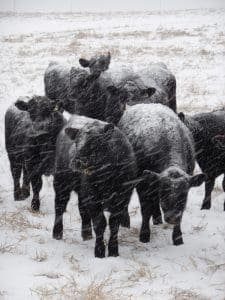By Patti Wilson, Contributing Editor
This Chuteside examines a multi-faceted topic, and a cutting-edge method of vaccination that is gaining momentum. Though at first it may not seem high-tech, the administration of intranasal vaccines has progressed and developed greatly due to constant research in bovines.
Thanks go to Tim Parks, DVM, of Merck Animal Health. His patient explanation of immune systems makes the subject matter easier to understand. Merck has developed Nasalgen®3, an IBR, PI3, BRSV vaccine that is currently new and available to U.S. livestock producers.
Why Intranasal?
In terms of physical use, intranasal vaccines are easier on the cattle, safer for the chute crew and effective against disease. They are Beef Quality Assurance (BQA) friendly, as well.
Parks explained that any injection site made by a needle has specific disadvantages. Inflammation, site lesions and potential spread of disease by contaminated needles are all bypassed by the use of an intranasal vaccine. Additionally, your crew will have a decreased risk of personal needle sticks, dropped, dirty needles, and vaccine administered improperly.
Chutes and calf cradles can impede placement of vaccine in proper injection sites, as well as intramuscular or subcutaneous dispersal of product. A nose, however, is a nose and is always found at the front end of an animal.
Mucosal tissue in the nasal cavities is an ideal place for uptake of the vaccine, with onset of protection against most pneumonia virus within three days. The Nasalgen®3 vaccine is effective for 6.5 months against infectious bovine rhinotracheitis (IBR).
The proximity of the nasal cavity to lymph nodes is an important asset to the efficiency of Nasalgen®3. Lymph nodes are important for proper immune functions, and vaccines enable them to recognize and trap specific pathogens. Likewise, any injected vaccines should be placed near other lymph nodes, each vaccine in its own specific site. In other words, spread out your shots within the injection site triangle of the neck.
The Life Cycle of Cattle
Starting at the beginning, cows must get pregnant and stay that way. Vaccinating pregnant cows can be risky in terms of triggering abortion. The Nasalgen®3 vaccine is safe for cows in calf, having been tested on a significant number of females. Additionally, it can be used safely with any stand-alone bovine viral diarrhea (BVD) vaccine, as long as label directions are followed.
Some injectable vaccines may cause abortion when young calves are IBR vaccinated, then pass along pathogens to their mothers through nasal shed. Nasalgen®3 is safe for the use on calves nursing cows.
Young Calves
Many cow-calf producers like to provide a vaccine to newborn calves. This will happen when birth weights are recorded and ear tags are assigned. The ingestion of good colostrum from the cow can interfere with injected vaccine products. Nasalgen®3, however, has demonstrated efficacy in the face of colostrum, providing added immunity for the newborn. This is called “bypass of maternal antibodies” and is an important element of effectiveness in the intranasal vaccine.
Weaned Calves and Yearlings
The conundrum of a pneumonia outbreak is especially difficult after weaning, when stress abounds like no other time. Nasal vaccination is especially helpful at this time when mucosal tissue is potentially loaded with harmful contaminants; 90 percent of pathogens enter cattle through the mucosal surface. Nasal vaccine is most effective, since there is more lymph tissue in the head area than any other part of the body. These lymph nodes can be stimulated in a very short time to protect calves, starting right where pathogens enter. The availability of lymph tissue and proximity of vaccine administration is paramount to successful immunization.
Parks warned against over-vaccinating livestock. Many producers work calves in the fall, preconditioning on the cow or on the day of weaning. It is a rare opportunity to capture and vaccinate. Subsequently, it’s easy to take this time to overstimulate the immune system, administer incompatible vaccines, or give shots in too few locations.
We are warned that the administration of too many gram-negative vaccines at one time can lead to shock-type reactions. Their byproduct, endotoxin, can be fatal when calves are overloaded. Pinkeye, Pasteurella and E.coli vaccines are typically gram negative. Hot, humid weather can adversely affect calves on working day, and feedlot dust contributes to the problem by contamination with gram negative bacteria. Be judicious in your choice of vaccines and make sure they are administered according to label directions.
Handling for Success
Parks recommends using a cannula on your syringe to administer Nasalgen®3. He likes the way it deposits the product far back in the nasal cavity. The farther back, the better, Parks says, so tip the animal’s head back, use a cannula and make sure it stays in the nostril well to ensure a good reaction to the vaccine.
He also recommends a new cannula for each calf, to protect against the spread of pathogens from calf to calf.
Nasalgen®3 is administered in a 2-milliliter dose. It is blue; color was added to help flag misplaced product and monitor employee skills – health products are only as good as the people who handle them. It can be used with a stand-alone BVD vaccine. Merck Animal Health recommends revaccinating in six months.
The new Merck product solidifies the company’s mission to strengthen immune systems in livestock, leading to a reduced use of antibiotics. Better livestock health benefits us all.
Dr. Tim Parks is a specialist in production medicine in the cow-calf and stocker sector. He is a Kansas native who has owned his own large animal veterinary clinic and became proficient in orthopedic surgery in small animals, as well. He earned his veterinary degree at Kansas State University College of Veterinary Medicine and is married to Dyann.





